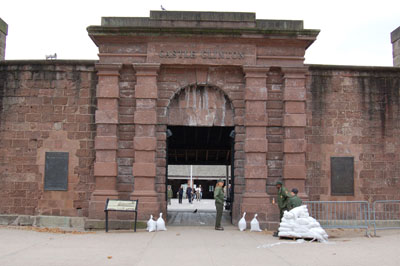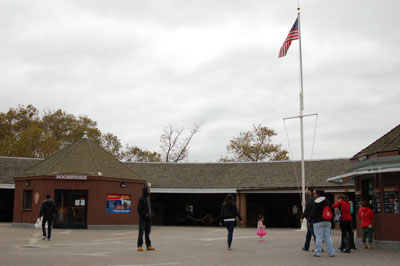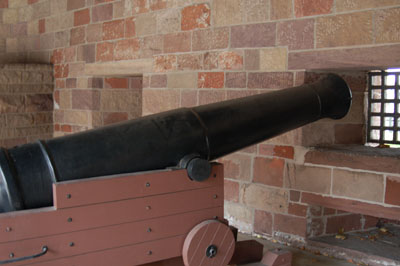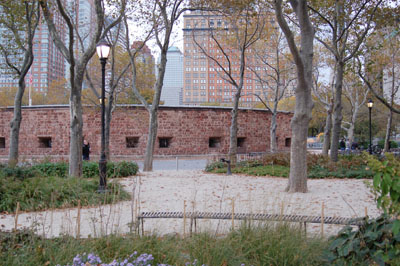
Castle Clinton fascinates, but not known
NEW YORK— One of the reasons I decided to write a feature on Castle Clinton National Monument is because I had never heard of it and knew that it would provide a good learning opportunity. Even though I knew nothing about it, I assumed that other people would. But the old adage “never assume anything” reared its ugly head and refused to back down as I embarked on a wild goose chase to find experts on the forgotten but fascinating national monument.
As I flew into New York and met up with the Columbia students I was staying with, none of them had even heard of Castle Clinton even though they were seniors who had been at the school for more than three years. They asked me where Castle Clinton was and seemed surprised to learn that it was in Battery Park. They were even more surprised to find out that the ticket booths for visits to the Statue of Liberty and Ellis Island are located inside the walls of the old fortress.
| Click on the video at right to view an audio slideshow about historic Castle Clinton prepared and narrated by writer Bolton Lancaster. |
Julian Cowan, a senior at Columbia University majoring in biology, had purchased tickets to the Statue of Liberty when he was visiting New York during his senior year of high school and was completely unaware that he had even visited Castle Clinton.
“I didn’t know I was in it. I don’t think anyone knows,” Cowan said. “No one has really heard of it.”
The mystery surrounding the national monument encouraged me to learn more about it. When the day came to visit Castle Clinton, I took the subway from Morningside Heights to the Financial District, emerged from the subway tunnel and quickly spotted Battery Park. It was a green oasis surrounded by the concrete and metal structures that make up Lower Manhattan.
The park had a number of trees that were starting to lose their leaves in the chilled October air as tourists packed the sidewalks, with children wearing seven-pointed foam crowns similar to the one worn by the Statue of Liberty. As I worked my way deeper into Battery Park, I quickly recognized Castle Clinton: an old brick wall about 20 feet high that extended in a complete circle with two openings on opposite sides of the circle.
 |
Guards lay sandbags outside of Castle Clinton National Monument and in the surrounding Battery Park area in preparation for Hurricane Sandy. The fortress is built on a man-made island that used to only be connected to Manhattan by a drawbridge in case the British attacked (Photos by Bolton Lancaster). |
I assumed that it must be a popular destination, as tourists seemed to be milling in and out of the entrances frequently. But again, I should not have assumed. As I worked my way inside the red brick walls, I noticed two small booths located in the middle of the circle. One of them was marked “Bookstore” while the other appeared to be a ticket window. At least a dozen people were waiting in a line at the ticket booth, speaking a wide range of languages.
I also noticed a small exhibit along the edges of the fortress that talked a bit about the restoration process of the monument. Additionally, there was a small museum exhibit at the opposite end of the circle that displayed the history of the national monument.
I approached a ranger who was on duty, hoping to ask him questions. After explaining that I was writing a story on Castle Clinton, I asked if I could ask him some questions.
“Uhh, talk to the head ranger over there,” the ranger said, pointing me in the direction of a different ranger.
I still do not know whether he was simply following procedures by having me talk to his boss or whether he legitimately did not feel comfortable answering questions about the park, but the fact that he was unwilling to talk about it at all gave me an uneasy feeling.
| Visitors wait in line to purchase tickets to the Statue of Liberty and Ellis Island. The site lies two blocks west from where Fort Amsterdam used to be located almost 400 years ago. |  |
After approaching the head ranger at the park and finding out that all interviews with rangers have to be set up through the National Park Service, I decided to simply talk to guests and get their perspective on the fortress.
I sat on a bench for 45 minutes by the small outdoor exhibit and observed the actions of the tourists and attempted to ask them questions. Seeing as how it was right by the exit of Castle Clinton, people only stopped if they were about to go outside the walls and the exhibit suddenly caught their attention. The national monument has essentially been reduced to an exhibition that people do not travel to specifically see, but rather take a few seconds to glimpse at after buying tickets to the Statue of Liberty or Ellis Island.
“Castle Clinton is a lesser-known spot because it is a jumping off point to other places,” said Pat Kirshner, operations director of the Battery Conservancy, an organization that was created in 1994 to rebuild and revitalize Battery Park and Castle Clinton.
Tickets for the Statue of Liberty and Ellis Island started being sold within Castle Clinton in 1986. This increased visitation by 1000 percent and made it one of the most visited National Park Service locations in the country.
 |
A model cannon stands inside the fortress, reminding visitors of Castle Clinton’s original purpose. After being constructed, the battery was armed with 28 cannons that would shoot 32-pound cannonballs and required 10 soldiers to run efficiently |
As I sat on the bench, I talked to every person who meandered over to the exhibit to learn more about the historic monument, which totaled about seven or eight people. Every single one of them either did not speak English or did not feel like they knew enough about Castle Clinton to answer questions. One woman walked over with her young son to look at the exhibit and learn about the site. After approaching her, I told her that I was writing a story and asked if I could interview her. She was openly unreceptive to the idea.
“I don’t really know much about it,” she said.
“You’re inside the walls and just learned a little bit by reading all of that information on the sign, right?” I replied.
“Sorry, I just don’t feel comfortable with it,” she said.
I started relating to how Woodward and Bernstein must have felt when they were digging up facts on the Watergate scandal. No one was willing to talk and I was confused as to why. Even after I returned home from New York, nearly every history professor who studied early American history said that Castle Clinton was not their area of expertise or that they did not feel comfortable talking about it.
It’s odd how a site with so much history can be forgotten even as three million people visit each year. Though many people might simply know it today as the structure that houses the ticket booth for the Statue of Liberty and Ellis Island, Castle Clinton has served a number of diverse roles over the years.
“Its history is part of the message we want to promote,” Kirshner said.
In the early 1800s, a young United States was gearing up for war with Great Britain. Four forts were built in the New York City area: Castle Williams on Governor’s Island, Fort Wood on Bedloe’s Island (known today as Liberty Island), Fort Gibson on Ellis Island and Southwest Battery on Manhattan Island.
Construction of Southwest Battery was completed in 1811, being built to defend Manhattan during the War of 1812. Southwest Battery was renamed Castle Clinton in 1815 after Dewitt Clinton, who served as mayor of New York City and went on to be elected as the governor of New York. The fort never ended up seeing any action during the war, but still had an important role to play in the future.
| Castle Clinton National Monument sits within Battery Park on the southern tip of Manhattan. The fortress was nearly destroyed in the 1940s during the attempted construction of a second Brooklyn Bridge. The project ended up being moved underground, resulting in the Brooklyn Battery Tunnel. |  |
In 1823, Castle Clinton was opened to the public as an entertainment center and renamed Castle Garden a year later. It served as a beer garden, restaurant, exhibition hall, opera house and theater. Additionally, many new inventions were demonstrated there, including the telegraph and Colt revolving rifle.
Perhaps the biggest performance at Castle Garden during the entertainment years was that of the famous Swedish opera singer Jenny Lind, who was known as the “Swedish Nightingale.” Her performance in 1850 marked her first in the United States.
In 1855, Castle Garden started serving as an immigrant-landing depot. It was the first of its kind in the country and marked the beginning of new immigration policies in the United States. Two out of every three immigrants who entered the country from 1855 to 1890 came through the gates of Castle Garden, including stunt performer Harry Houdini.
The more spacious and isolated Ellis Island replaced Castle Garden as the New York immigrant-landing depot in 1892. Although a fire on Ellis Island in 1897 destroyed a lot of the immigrant passenger forms from Castle Garden, it is widely believed that between eight and 12 million immigrants were processed at Castle Garden during its immigration years.
In 1896, Castle Garden started serving a new function: the site of the New York City Aquarium. It became one of the most popular attractions in the city, averaging over 5,000 visitors per day. The aquarium became famous for its exotic fish and for housing America’s first captive beluga whale. The New York City Aquarium was relocated to Coney Island in 1941, where it still stands today.
After nearly being destroyed in 1946 to make room for a proposed second Brooklyn Bridge, Castle Garden was restored to its original condition by the National Park Service. It reopened in 1975 and was renamed Castle Clinton. Parts of the original wall can still be seen at the site today.
Although there might not be many people who know a lot about Castle Clinton National Monument, I was still able to find a plethora of information on it because of its rich history. It might simply be looked at as the place to buy tickets for the Statue of Liberty and Ellis Island, but that reputation could be changing soon.
“We do have plans to renovate it and bring it back to the life of the city,” Kirshner said.
A total of $8.6 million has been raised between public funds and private gifts to go towards the reconstruction of Castle Clinton. In 1999, an international architectural competition was held to see who would design the new site. An architecture firm’s design has been chosen, but it will not be presented to the public until 50 percent of the construction funds have been secured.
According to the Battery Conservancy, the rebuilt Castle Clinton will have three main functions: a transportation hub, a performing arts center and a new interpretive center that will focus on the history of the site.
Even though the new Castle Clinton is not built and the plans are not available to the public, it is still worth visiting the site today. Cowan, who had never even heard of the site before I told him about it, says that he wants to visit now that he knows more about the history.
“I think it sounds interesting,” Cowan said, adding that Castle Clinton probably does not receive as much attention because it is within the more well known Battery Park.
“Castle Clinton is kind of the jewel of the park,” Kirshner said. “It is one of the most adapted historic structures around.”
Even though tracking down people to talk to about the site was difficult, it was an ultimately rewarding experience for me to be able to step back in time and learn about the old fortress. It is a treasure of New York City that does not receive the recognition it deserves.
Castle Clinton has served a number of different roles through the years, and it hardly seems to be done serving as an important site for New York residents and tourists alike.
If You Go
Castle Clinton is located in Battery Park at the southern tip of Manhattan.
The site is open every day from 8:30 a.m. to 5 p.m. with the exception of Christmas Day. It is free to visit.
Castle Clinton may close during severe weather conditions. To see whether it is open, call the phone number listed below.
Ranger-guided tours are offered every day. The daily schedule is posted on the door of the Castle Clinton Exhibit.
Public transportation is a good way to get to Castle Clinton. MTA New York Transit information can be found at http://www.mta.info/nyct/. Another good alternative is to bike there. There are bicycle racks at the site.
Castle Clinton can be contacted at 212-344-7220. More information can be found online at http://www.nps.gov/cacl/index.htm.

Comments are Closed